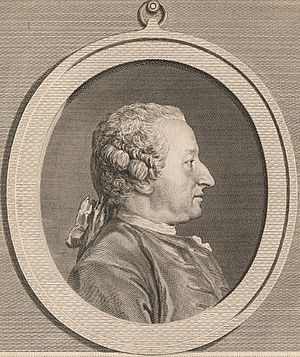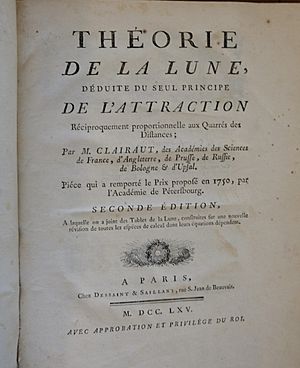Alexis Clairaut facts for kids
Quick facts for kids
Alexis Claude Clairaut
|
|
|---|---|

Alexis Claude Clairaut
|
|
| Born | 13 May 1713 Paris
|
| Died | 17 May 1765 (aged 52) Paris
|
| Nationality | French |
| Known for | Clairaut's theorem Clairaut's theorem on equality of mixed partials Clairaut's equation Clairaut's relation Apsidal precession |
| Scientific career | |
| Fields | Mathematics |
Alexis Claude Clairaut (born May 13, 1713 – died May 17, 1765) was a brilliant French mathematician, astronomer, and geophysicist. He was a big supporter of Sir Isaac Newton's ideas. Clairaut's work helped prove that Newton's theories about how the universe works were correct. He was part of an important trip to Lapland that helped figure out the true shape of the Earth. During this trip, he developed a math idea now called "Clairaut's theorem". He also worked on the difficult problem of how three objects in space pull on each other with gravity. He was the first to successfully explain the Moon's changing orbit. In math, he is also known for Clairaut's equation and Clairaut's relation.
Contents
Biography
Childhood and early learning
Alexis Claude Clairaut was born in Paris, France. His father, Jean-Baptiste, taught mathematics. Alexis was a true child prodigy. When he was just ten years old, he started studying calculus, a type of advanced math.
By age twelve, he wrote a paper about four special curves in geometry. When he was thirteen, he shared his discoveries with the Académie française, a famous French academy. At sixteen, he finished a book called Recherches sur les courbes a double courbure (meaning "Research on Curves with Double Curvature"). This book was published in 1731. Because of his amazing work, he was allowed to join the Royal Academy of Sciences even though he was only eighteen, which was younger than the usual age.
Life and passing
Clairaut never married. He enjoyed a very active social life. His popularity in society sometimes made it harder for him to focus on his scientific work. He was known for enjoying dinners and social evenings.
Despite his busy social life, he was very helpful in guiding young mathematicians. He was elected a Fellow of the Royal Society of London on October 27, 1737. Clairaut passed away in Paris in 1765, at the age of 52.
Scientific Discoveries and Math Work
Understanding Earth's shape
In 1736, Clairaut joined Pierre Louis Maupertuis on a trip to Lapland. The goal was to measure a part of the Earth's surface called a meridian arc. They wanted to use geometry to figure out the exact shape of the Earth. Sir Isaac Newton had suggested in his book Principia that Earth was shaped like an ellipsoid, which is like a slightly flattened sphere. The expedition aimed to prove if Newton's idea was right.
Before returning to Paris, Clairaut sent his math calculations to the Royal Society of London. His findings were later published in their Philosophical Transactions in 1736–37. At first, Clairaut had some disagreements with Newton's exact numbers for Earth's shape. In his article, he pointed out some challenges in Newton's calculations. He also offered some ways to solve these problems.
Clairaut's work helped confirm that Earth is indeed an oblate ellipsoid. This means it is slightly flattened at the poles and bulges a bit at the equator. After his trip, he published a major book called Théorie de la figure de la terre (1743). In this book, he shared his famous "Clairaut's theorem". This theorem connects the gravity on the surface of a spinning ellipsoid (like Earth) with how flat it is and the force pushing outwards at the equator. This helped prove Newton's theory about Earth's shape.
Geometry made simple
In 1741, Clairaut wrote a book called Éléments de Géométrie (Elements of Geometry). This book explained the basic ideas of geometry. Back in the 1700s, geometry was often seen as a difficult and boring subject. Clairaut wanted to make it more interesting for students. He believed that instead of just solving problems without understanding, students should discover things for themselves. This is a form of experiential learning, where you learn by doing.
He started his book by comparing geometric shapes to measuring land, which was something most people could understand. He covered topics like lines, shapes, and even three-dimensional objects. Throughout the book, he connected geometry to other subjects like physics, astrology, and other parts of mathematics. Some of his ideas for teaching geometry are still used by teachers today.
Focus on how planets move
One of the biggest challenges for scientists in the 1700s was the "problem of three bodies." This problem tries to figure out how the Earth, Moon, and Sun all pull on each other with gravity. Using the new math tool called calculus, Clairaut found a way to solve this problem. He used four special math equations. He also included Newton's ideas about gravity, making only small changes. However, these equations only gave approximate answers, not exact ones.
Another puzzle was how the Moon's orbit changes over time. Even Newton could only explain half of this change. This mystery bothered many astronomers. Clairaut even thought about suggesting a new idea for how gravity works because it seemed so hard to explain.
The question of the Moon's orbit was a hot topic in Europe. Two other famous mathematicians, Leonhard Euler and Jean le Rond d'Alembert, were also trying to solve it. They argued against using Newton's laws directly for this problem. Euler, for example, thought Newton's law of gravity might need to be changed to correctly calculate the Moon's orbit.
Despite the competition, Clairaut found a clever way to solve the three-body problem. In 1750, he won a prize from the St Petersburg Academy for his essay Théorie de la lune (Theory of the Moon). Clairaut, along with Jérome Lalande and Nicole Reine Lepaute, successfully predicted when Halley's comet would return in 1759.
His Théorie de la lune used Newton's ideas. It explained the Moon's changing orbit. Clairaut realized that if he made his calculations even more precise, the results matched what astronomers observed. In 1754, he created tables for the Moon's position, using a method similar to what we now call a discrete Fourier transform.
Solving the three-body problem was very important. It meant that Newton's laws were indeed correct. It also had a practical use: sailors could now figure out their longitude (their east-west position) at sea. This was vital for navigation and trade, helping ships find their way to distant lands and back home.
Clairaut later wrote many papers about the orbit of the Moon. He also studied how planets affect the movement of comets, especially Halley's comet. He used math to study Venus too, making accurate measurements of the planet's size and its distance from Earth. This was the first time Venus's size was measured so precisely.
See also
 In Spanish: Alexis Claude Clairaut para niños
In Spanish: Alexis Claude Clairaut para niños
- Clairaut's equation
- Clairaut's relation
- Clairaut's theorem
- Differential geometry
- Human computer
- Intermolecular force
- Symmetry of second derivatives



